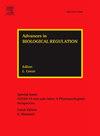以芽殖酵母为中心的氧甾醇结合蛋白家族功能的观点。
IF 2.4
Q1 Biochemistry, Genetics and Molecular Biology
引用次数: 0
摘要
跨高尔基网络(TGN)/内体系统是通过顺行分泌途径和内化质膜物质的内吞途径带来的货物的分拣中心。由于许多经过这个中心运输枢纽的货物是关键稳态信号通路的组成部分,TGN/核内体定义了细胞生长控制的关键信号枢纽。TGN/内体功能调控的一个特别有趣但尚未完全了解的方面是脂质交换/脂质转移蛋白的两个家族对该系统的控制。磷脂酰肌醇转移蛋白促进前运输磷酸肌醇(即磷脂酰肌醇-4-磷酸)信号通路,而氧甾醇结合蛋白家族的蛋白质在拮抗磷酸肌醇信号通路中发挥相互作用。这些脂质结合蛋白如何执行其功能的确切机制仍有待解决。此外,关于氧甾醇结合蛋白家族的个体成员与特定生物活性的偶联的信息尤其稀少。在此,我们回顾了酵母模型系统中关于氧甾醇结合蛋白家族功能的研究进展。重点主要集中在Kes1/Osh4蛋白的讨论上,这是可获得信息最多的蛋白。本文章由计算机程序翻译,如有差异,请以英文原文为准。
A budding yeast-centric view of oxysterol binding protein family function
The Trans Golgi Network (TGN)/endosomal system is a sorting center for cargo brought via the anterograde secretory pathway and the endocytic pathway that internalizes material from the plasma membrane. As many of the cargo that transit this central trafficking hub are components of key homeostatic signaling pathways, TGN/endosomes define a critical signaling hub for cellular growth control. A particularly interesting yet incompletely understood aspect of regulation of TGN/endosome function is control of this system by two families of lipid exchange/lipid transfer proteins. The phosphatidylinositol transfer proteins promote pro-trafficking phosphoinositide (i.e. phosphatidylinositol-4-phosphate) signaling pathways whereas proteins of the oxysterol binding protein family play reciprocal roles in antagonizing those arms of phosphoinositide signaling. The precise mechanisms for how these lipid binding proteins execute their functions remain to be resolved. Moreover, information regarding the coupling of individual members of the oxysterol binding protein family to specific biological activities is particularly sparse. Herein, we review what is being learned regarding functions of the oxysterol binding protein family in the yeast model system. Focus is primarily directed at a discussion of the Kes1/Osh4 protein for which the most information is available.
求助全文
通过发布文献求助,成功后即可免费获取论文全文。
去求助
来源期刊

Advances in biological regulation
Biochemistry, Genetics and Molecular Biology-Molecular Medicine
CiteScore
8.90
自引率
0.00%
发文量
41
审稿时长
17 days
 求助内容:
求助内容: 应助结果提醒方式:
应助结果提醒方式:


